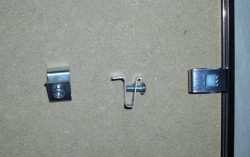 Ever hear of “the curse of knowledge”? It’s the idea that knowing something well can sometimes be a problem (rather than a benefit). When you know the thinking about a particular web design or how a chair should be put together (I’m looking at you, Ikea), it seems easy and obvious. The trouble is those without your inside information may find themselves completely stumped.
Ever hear of “the curse of knowledge”? It’s the idea that knowing something well can sometimes be a problem (rather than a benefit). When you know the thinking about a particular web design or how a chair should be put together (I’m looking at you, Ikea), it seems easy and obvious. The trouble is those without your inside information may find themselves completely stumped.
For example, the photo on the right is the hardware that came with my new picture frame. I figured out the clips (the piece stuck in the frame on the far right) pretty quickly, but was stumped about the v-shaped hardware.
It looked like the clips were there to help hang the frame it on the wall, but I couldn’t figure out how they were meant to work. The best I could figure was that the V-shaped piece should slide in somehow, but it didn’t hold when I tried it. Since I am a writer, rather than an engineer, I sent a photo to my brother (who is an engineer). He was stumped too.
Tech support
Then, I called “tech support” at A.I. Friedman (the art supply store where it came from). I left a message, but wasn’t sure if anyone would get back to me (they did, later). Since I really wanted to hang that poster, I decided to take it down to the hardware store around the corner. If he had no clue, there was a framing place next door. One of them should be able to help me.
Hardware to the rescue
The hardware guy figured it out. I’d had the right idea. You had to loosen the screw first, then slide the V-shaped piece in, then insert the picture wire and voila!
It’s too hard
It took three smart people an hour or so to figure this out. There’s a parallel to web sites and marketing too. A simple piece of paper with an illustration and instructions would have solved the problem. Maybe the solution was obvious to the manufacturer, but it wasn’t to me or to an engineer.
I remember seeing an example of a web designer who changed their site every week! All the examples were beautiful, but imagine trying to use that site regularly? The colors kept changing, the menus moved around; it was impossible to find anything.
Don’t confuse people
Now, take a look at your own website or other marketing materials. Are they easy to use? What’s the bounce rate on your key pages? Are people coming to your site and then leaving because they can’t figure out what to do?
Or, do you have too many options? When people are overwhelmed with options, they are likely to leave your site, without buying anything.
Check the simple things too. Is it easy to contact you, and is it easy to find that information? Is there a pop-up or a Flash presentation that covers the content? Can they be closed easily, and is the method obvious?
If you’re not sure, ask some of your current customers or clients. Or, try showing your site to someone else, who doesn’t work for you. Can they navigate it? Or do they need to call “tech support?”
